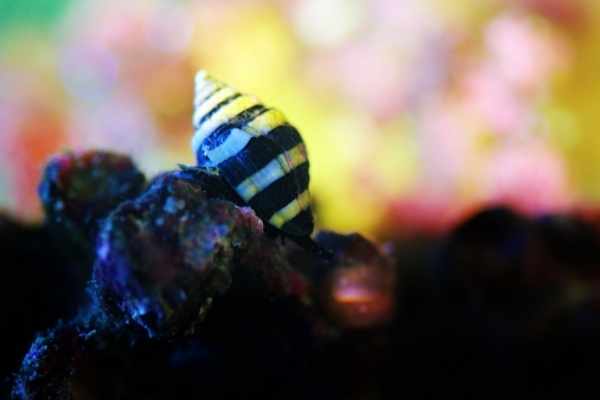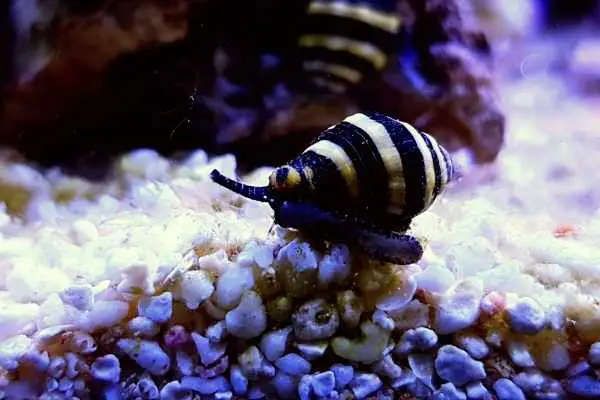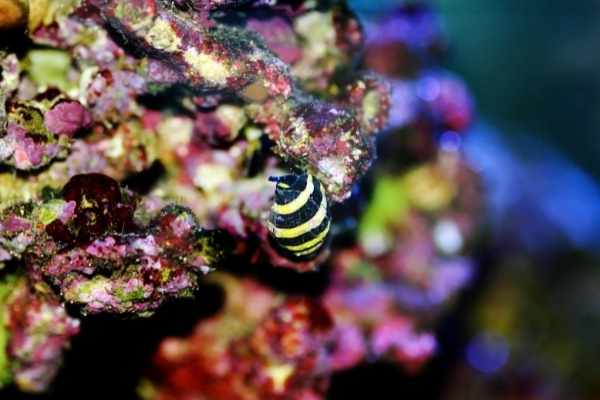The bumblebee snail (Engina mendicaria) checks off all of the popular categories: They’re colorful (if you couldn’t guess from their name). You won’t have trouble caring for them. And they provide multiple benefits to your saltwater aquarium. Not too shabby for a little gastropod! Of course, there are a few minor hiccups – but what species doesn’t have those?
Table of Contents: Bumblebee Snail
Despite their tiny size, bumblebee snails are powerhouses. They scour the tank for detritus, joining in as a member of the clean-up crew. And they look gorgeous doing so. If you’re willing to keep them safe and healthy (which the links below will coach you through), you’ll reap the rewards of a shining, potentially pest-free aquarium. Pest-free? Got your interest now! (And you’ll have to read on to learn more)
- Quick Facts
- Description of the Bumblebee Snail
- Bumblebee Snail Lifespan
- Creating the Ideal Bumblebee World
- Bumblebee Snail Diet
- Bumblebee Snail Behavior and Tank Mates
- Breeding the Bumblebee Snail
- Pros and Cons
- For More Information

Quick Facts
- Common Names: Bumblebee snail, Striped engina
- Scientific Names: Engina mendicaria
- Size:5 inch (1.3cm)
- Minimum Tank Size: 5 Gallons (19L)
- Reef Safe? Yes
- Care or Experience Level: Easy
- Preferred Diet: Omnivore
- Original Part of the World: Indo-Pacific
Description of the Bumblebee Snail
Okay, so it’s not surprising how the bumblebee snail got its name. This itty-bitty whelk has a shell striped in alternating black and yellow (or sometimes white). It’s a striking pattern that immediately puts people in mind of bees or wasps. The snail body’s a neutral shade inside the shell, and you’ll see a long proboscis. The proboscis is the “mouth” the bumblebee uses to search and consume bits of food.
Bumblebees belong to the Pisaniidae family (part of the Buccinoidea superfamily). These sea snails all possess dramatic shells people covet. They’re also predators. And while bumblebee snails are tiny (no more than 0.75 inch/0.9cm maximum), those black and yellow stripes are exceptional. Beads made from the shells date back as far as 5000 BC. (Not that you’re planning to open a jewelry business, but it’s cool to know)
That compact size comes in handy as the snails scout around for detritus. Bumblebee snails can fit into the tight spaces other clean-up crew members might miss. They also burrow into the substrate, helping to aerate the sand. (Not to mention cleaning out any debris) As that conical shell moves and digs around, it loosens the grains of sand, releasing pockets of trapped air – and potential waste.

Bumblebee Snail Lifespan
You’ll spot bumble bee snails throughout the Indo-Pacific. They’re a tropical species that congregates around reefs in the intertidal zone. Snorkeling is the better option for spotting them, though. These snails aren’t fans of deep water. You might even see them in small pools as the tide shifts out, crawling in and around rocks.
All whelks (well, all gastropods) use calcium to build new “rings” on their shells as they age. It’s how researchers determine the lifespans of the species. Of course, you need a quality magnifying glass (or a microscope) to count the lines on a snail as tiny as a bumblebee. Rather than putting your eyes out of focus, go with the average captive lifespan of 2 years. (Not too shabby for a gastropod of that size)
Creating the Ideal Bumblebee World
Bumblebee snails show up on islands throughout the Indo-Pacific. People report spotting them around Chagos, Hawaii, Kenya, Indonesia, Madagascar, Mauritius, Mozambique, and Tanzania. And, of course, the shells of bumblebees that have passed wash ashore in those areas. The gastropods hide under rocks and climb around the reefs.
And while it’s not uncommon to spot bumble bee snails in marshy areas (regions people think of as “in flux”), you want to ensure your aquarium has finished cycling. Snails, in general, have a low tolerance for nitrates. And any fluctuations in your water parameters will cause problems for your bumblebees. Best to wait until your tank matures before you introduce one of these stripey whelks. (Also – as with any invertebrate – you need to skip copper-based medications)
Once your tank’s set up, you’ll need to monitor the calcium levels. That whelk shell is composed of calcium. If you want your snail to grow, it will need calcium to build the shell. Of course, if you have a reef tank, you’re already monitoring your calcium (and magnesium). But it’s essential to ensure all of your invertebrates have enough resources. When you add these gastropods, increase your testing to double-check that everyone’s happy.

Then you need to consider ALL of the aspects of their behavior. Bumblebees belong to the clean-up crew. So, they’ll climb in, on, and around your live rock, picking up leftover bits of food and waste. The natural caves and crevices will also offer places to hide out. (Don’t forget how tiny these snails are)
But you can’t neglect that burrowing habit. Bumblebee snails require a deep sand bed to stay happy. As these gastropods are on the small side, you don’t need to go TOO far, though. A depth of 1-2 inches (2.5-5cm) will work. (Okay, so TECHNICALLY that isn’t a deep sand bed) You’re looking for enough substrate for the snail to bury itself. And as they move around, the motion of the shell will keep the sand aerated. You won’t need to worry about trapped nitrogen pockets.
The sand bed offers the bumblebee another place to retreat and hide, as well. That shell provides some protection, of course, but they’re still vulnerable. You want to ensure they have as much cover and safety as possible. (Yes, even if you avoid known predators as tank mates)
Bumblebee Snail Tank Size
With an average size of only 0.5 inch (1.3cm) for an adult bumblebee snail, it’s tempting not to worry about tank size. Pop your little gastropod cleaner in and enjoy the benefits of their scavenging, right? Not so much. While tiny, these snails still require space. Even if it isn’t a TON of space.
You’ll want around 5 gallons (19L) per bumblebee. This allows them the roaming territory they need without feeling confined or overwhelmed. You can certainly house multiple snails together, but you don’t want to create a pinch on resources. If a bumblebee snail can’t find its preferred menu options, it will turn to sources you’d rather not see disappear from the aquarium. Ensuring enough room for everyone prevents that from happening.
Are Bumblebee Snails Reef-Safe?
Bumblebee snails hang out on reefs throughout the intertidal region. And it’s common to find them scouring corals for bits of debris. But they don’t eat coral. So, you’re in the clear to add them to your reef tank. (Which you probably already guessed)
There’s a caveat, though, and it ties back into that stocking issue. Bumblebees are omnivores, which means they’re opportunistic. And they’ll eat ANYTHING. If your snails can’t find any detritus to feed on (congratulations – your tank’s clean), they’ll start hunting for something else. The corals themselves are safe, but the food those polyps depend on? Yeah, that’s fair game. And snails can move; corals can’t.
Bumblebees will also go after polychaetes. You may or may not be attached to the bristle worms that hitchhiked into your tank, but what about other worms? And then there’s the snail issue. These whelks WILL attack and devour smaller snail species when hungry. You don’t want to risk losing other invertebrates in your tank.

Bumblebee Snail Diet
Bumblebee snails are connoisseurs of detritus. This means they’ll sample a little of everything: leftover bits of food, waste that drifts onto the rock structures, and decomposing organic matter in the substrate. It’s why hobbyists appreciate having them around. They work their way around the tank, cleaning up everything they encounter.
But the snails are the biggest fans of meaty proteins. So, you’re not going to see your bumblebees tackling algae problems. (You’ll want another gastropod species for that) And if your tank runs too efficiently or you overstock on cleaning crew members, that carnivorous tendency can cause problems. These snails WILL consume other snails, polychaetes, and other invertebrates. Just on a tiny scale. While potentially helpful, it can also lead to problems (say, if you were counting on invertebrates for algae control).
When your tank comes up short on food sources – and you don’t want those bumblebee snails to go hunting – you’ll need to provide supplemental menu choices. But that’s pretty easy:
Chop the pieces up (remember how small that proboscis is) and scatter them in front of your snails. They’ll take care of the rest.
Bumblebee Snail Behavior and Tank Mates
As with most sea snail species, bumblebees do most of their work under cover of darkness. (Those colors work for Batman, too!) Once the sun goes down, they crawl out of hiding to search for a meal. Of course, you may wonder if your snail’s doing anything – even at night. They’re not the fastest (and that’s saying something!).
Bumblebee snails will keep to the rocks depending on the debris available. If the pickings are slim, they’ll head into the sand. And only if the substrate’s depth is sufficient. Some hobbyists never see their snails burrow. There’s not necessarily anything wrong with the set-up, either. The whelk may feel comfortable and have enough resources above the sand. And when they find a good spot to feed? They stay there.
The snail-eating habit of bumblebees attracts hobbyists for one reason: eliminating vermetid snails. Vermetids are pests that cause problems in reef tanks. And bumblebees ARE known to hunt down and snack on the tube snails. But you shouldn’t count on the habit, especially if you have a bad infestation. Bumblebees are TINY and SLOW. Expecting one snail to cope with a vermetid explosion is unreasonable. You’ll need a cohort. And patience. (Or you’ll want to consider another elimination method)
The same applies to anyone hoping to eliminate unwanted polychaetes. Bumblebee snails WILL devour the worms – when they catch them. But the speed difference is amusing. You’ll want a backup plan if you’re worried about an infestation of bristle worms. And keep in mind that bumblebees may NOT eat the pest you want to eliminate. Every snail’s different; they may have another meal in mind.

If you have other snails in your tank, you probably don’t need to worry. Bumblebees are, overall, peaceful. And when they encounter a bigger gastropod, they leave them alone. (No Napoleon Complex here) So these tank mates are safe:
- Astrea snails
- Cerith snails
- Fighting conchs
- Mexican turbo snails
The same goes for the crustacean members of the clean-up crew. Shrimp are too large to present a temptation to the snails. And even tiny sexy shrimp won’t end up on the menu. Your bumblebee snail will simply clean around them and move on.
But those black and yellow colors attract attention. And bumblebees are (unfortunately) bite-size. So even if you offer plenty of hiding places – and the deep sand bed – you’ll want to avoid some of the more aggressive snail eaters out there:
- Coral banded shrimp
- Hermit crabs
- Wrasses
Breeding the Bumblebee Snail
Wouldn’t it be nice to breed bumble bee snails? You could develop your own line of striped clean-up gastropods. It’s a nice dream – that’s going to stay a dream, unfortunately. No one’s managed to successfully breed the species in captivity. They’re challenging to manage.
To start, species in the Pisaniidae family engage in sexual reproduction (not something you often see in sea snails). Easy enough, right? Except no one knows how to tell male and female bumblebees apart. You can easily end up with a tank full of one sex. And continuously adding more and more snails isn’t recommended.
Then comes the question of how to trigger spawning. No one’s positive about what you need to do. Obviously, the usual ideas of proper resources and somewhere safe to lay the eggs make sense. Some hobbyists suggest providing the snails with access to natural sunlight. And others have bumped up the temperature in the tank. But there’s no hard-and-fast guide to success.
As snail eggs are a delicacy for fish and other invertebrates, though, if you’re lucky enough to find yourself with a spawning event, consider protecting the bumblebee offspring. You probably don’t want to move the eggs and risk losing ideal conditions, though.
Pros and Cons
Bumblebee snails have fascinated people for centuries (literally). Even if they weren’t always piquing our interest in the aquarium hobby. And while they’re not the most imposing, or even demanding, addition to your tank, it’s still important to consider the pros and cons before you rush out and purchase one (or ten).
Pros
- Bumblebee snails scour tanks for all manner of detritus, even burrowing into deep sand beds and helping to aerate the substrate.
- You can comfortably manage multiple bumblebees in the average aquarium at a stocking size of one snail per 5 gallons (19L).
- Bumblebee snails have peaceful demeanors despite their carnivorous leanings – provided they have adequate food resources available.
Cons
- Bumblebee snails require calcium levels of 350-450ppm to ensure continued healthy shell growth.
- While bumblebees have a reputation for eating other snails (like vermetids) and polychaetes (like bristle worms), they’re too slow and small to handle large infestations.
- Bumblebee snails are notoriously difficult to breed in captivity.
For More Information
How do you resist an adorable bumble bee snail? Just looking at that striped shell brings a smile to your face. And when you see their hard work throughout the tank, you’ll wonder how you ever did without them. Sure, you need to fuss with a deep sand bed, but isn’t the effort worth it when that snail burrows into the substrate? Do you even need additional details to convince you? (We’ve got them, but do you need them?)
This YouTube video shows bumble bee snails at work in an average reef tank:
Want to know about some of the best bumblebee snail tank mates?
You’re already setting up a deep sand bed for your bumble bee snails, so why not learn about some other species who’d appreciate all that substrate?
Conclusions
Maybe your bumblebee snails won’t eliminate a vermetid invasion. But if you have one or two of the pests, they can probably tackle the problem. And the whelks undoubtedly get to work cleaning the bits of food and waste collecting in the crevices and corners of the rock structures within your tank. You know the spots – places you struggle to reach.
Bumblebees add that little bit of color to a reef tank you never knew you needed. And they don’t bother anyone as they work. Well, as long as they’re well-fed, anyway. But considering their tiny size, that isn’t a problem for the average aquarium. So why not consider adding one or two (or ten) to your next tank?
Think these little gastropods are worth a bit of fuss? Or is the need for the deep sand bed too much to ask?
References
- Calfo, A. and Fenner, R. 2003. Reef Invertebrates: An Essential Guide to Selection, Care, and Compatibility.


Leave a Reply